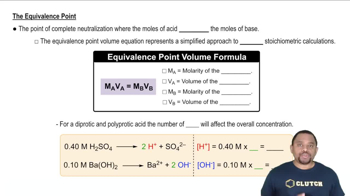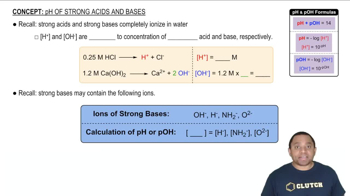A 40.0 mL sample of a mixture of HCl and H3PO4 was titrated with 0.100 M NaOH. The first equivalence point was reached after 88.0 mL of base, and the second equivalence point was reached after 126.4 mL of base. (a) What is the concentration of H3O+ at the first equivalence point?
Ch.17 - Applications of Aqueous Equilibria
Chapter 17, Problem 148f
A 40.0 mL sample of a mixture of HCl and H3PO4 was titrated with 0.100 M NaOH. The first equivalence point was reached after 88.0 mL of base, and the second equivalence point was reached after 126.4 mL of base. (f) What indicators would you select to signal the equivalence points?
 Verified step by step guidance
Verified step by step guidance1
Step 1: Understand the titration process. In this problem, you are dealing with a mixture of HCl (a strong acid) and H3PO4 (a triprotic acid). The titration with NaOH will have multiple equivalence points due to the different acidic protons being neutralized.
Step 2: Identify the equivalence points. The first equivalence point corresponds to the complete neutralization of HCl and the first proton of H3PO4. The second equivalence point corresponds to the neutralization of the second proton of H3PO4.
Step 3: Choose an indicator for the first equivalence point. Since the first equivalence point involves the neutralization of a strong acid (HCl) and the first proton of a weak acid (H3PO4), the pH at this point will be slightly acidic. An indicator like methyl orange, which changes color in the pH range of 3.1 to 4.4, would be suitable.
Step 4: Choose an indicator for the second equivalence point. The second equivalence point involves the neutralization of the second proton of H3PO4, which is a weak acid. The pH at this point will be more neutral. An indicator like phenolphthalein, which changes color in the pH range of 8.2 to 10.0, would be appropriate.
Step 5: Consider the pH range of the indicators. Ensure that the chosen indicators have a color change range that encompasses the expected pH at each equivalence point to accurately signal the completion of each stage of the titration.

Verified video answer for a similar problem:
This video solution was recommended by our tutors as helpful for the problem above.
Video duration:
4mWas this helpful?
Key Concepts
Here are the essential concepts you must grasp in order to answer the question correctly.
Titration and Equivalence Points
Titration is a quantitative analytical method used to determine the concentration of a solute in a solution. The equivalence point in a titration occurs when the amount of titrant added is stoichiometrically equivalent to the amount of substance being titrated. In this case, the first and second equivalence points indicate the complete neutralization of HCl and H3PO4, respectively, by NaOH.
Recommended video:
Guided course

Equivalence Point in Titration
Indicators in Titration
Indicators are substances that change color at a specific pH range, signaling the completion of a titration. The choice of indicator depends on the pH at the equivalence point of the titration. For strong acid-strong base titrations, phenolphthalein is commonly used, while for weak acid-strong base titrations, methyl orange or bromothymol blue may be more appropriate.
Recommended video:
Guided course

Best Indicator Example
Acid-Base Strength and pH
The strength of an acid or base affects the pH at the equivalence point. Strong acids like HCl fully dissociate in solution, while weak acids like H3PO4 do not. This difference means that the pH at the equivalence point for HCl will be around 7, while for H3PO4, it will be lower than 7, necessitating the use of different indicators to accurately signal the equivalence points.
Recommended video:
Guided course

pH of Strong Acids and Bases
Related Practice
Textbook Question
Textbook Question
A 40.0 mL sample of a mixture of HCl and H3PO4 was titrated with 0.100 M NaOH. The first equivalence point was reached after 88.0 mL of base, and the second equivalence point was reached after 126.4 mL of base. (b) What are the initial concentrations of HCl and H3PO4 in the mixture?
Textbook Question
A 40.0 mL sample of a mixture of HCl and H3PO4 was titrated with 0.100 M NaOH. The first equivalence point was reached after 88.0 mL of base, and the second equivalence point was reached after 126.4 mL of base. (c) What percent of the HCl is neutralized at the first equivalence point?
Textbook Question
A 1.000 L sample of HCl gas at 25°C and 732.0 mm Hg was absorbed completely in an aqueous solution that contained 6.954 g of Na2CO3 and 250.0 g of water. (a) What is the pH of the solution?
Textbook Question
A saturated solution of an ionic salt MX exhibits an osmotic pressure of 74.4 mm Hg at 25 °C. Assuming that MX is completely dissociated in solution, what is the value of its Ksp?
